
by Toyota Media / ModernRacer.com
Most people believe that cars powered by both electric and gasoline systems are a relatively new technology. But in fact, hybrid technology is as old as cars themselves. It is just that manufacturers have only recently begun to seriously look into these systems again, as gasoline prices rise, oil supplies become harder to come by and cities are choking on pollution.
It's clear Leonardo da Vinci had an idea that humans could, maybe, build a flying machine. But his timing was off by the roughly 400 years or so it took for advancing technology to supply the materials, engines, and airfoil shapes to make the vision take flight. Leonardo was full of ideas that were just out of sync with his time.
 2004 Toyota Prius
2004 Toyota Prius
|
So, too, were the earliest hybrid vehicle concepts. Way back on November 23, 1905, a fellow by the name of H. Piper applied for a patent for a vehicular powertrain in which an electric motor would augment a gasoline engine. According to the patent application, this would allow a vehicle to accelerate from zero to the then-exhilarating speed of 25 miles per hour in just 10 seconds. Since contemporary cars took up to four times that long, Mr. Piper's notion had obvious merit, even if the freeway onramp had yet to be invented. But Piper's timing was off. The next few years delivered rapidly escalating technology of the gasoline engine and the availability of relatively cheap and easily transportable fuel. Coupled with that was a near-complete lack of electrification of the United States, gross inconsistency among what electrical power grids did exist and, to make it worse, what little electricity was available was exorbitantly priced.
Mr. Piper was not alone as a hybrid visionary. From 1897 to 1907, the Compagnie Parisienne des Voitures Electriques (roughly, Paris Electric Car Company), built a series of electric and hybrid vehicles, including the 1903 Krieger. With front-drive and power steering, the Krieger wasn't built in much quantity. One model ran on alcohol, and there was another version with what has been described as a gasoline-turbine engine; in those times, the term "turbine" sometimes meant “generator."
 1903 Krieger
1903 Krieger
|
Within, roughly, this same time frame, Jacob Lohner & Co., in Austria, was building electric cars and one of the employees was an inventive young engineer named Ferdinand Porsche. He devised a system in which the electric motors were one and the same with the wheel hubs, thus eliminating the troublesome componentry of complicated transmissions to deliver the power directly to the wheels. These were known as Lohner-Porsches, and later the company produced a line of vehicles in which a gasoline engine drove a generator, which in turn provided the electrical juice for the electric motors. This is the classic, conceptually fundamental hybrid.
Around 1900, General Electric built a hybrid with a four-cylinder gasoline engine. The Siemens-Schuckert Company in Berlin, Germany, was a builder of, primarily, electric cars and commercial vehicles, but built some hybrids until ceasing production in 1910 or so. In Chicago, the Woods Motor Vehicle Company produced the 1917 Woods Dual Power, a parallel hybrid (meaning the electrical and the gasoline-burning sections could work together) with a four-cylinder gasoline engine. It could make only 20 mph running solely as an electric, but with the gasoline engine adding its 12 horsepower was good for 35; moderate performance at best. One of these is part of the collection at the Petersen Automotive Museum in Los Angeles. Another Chicago firm, the Walker Vehicle Company, built both electric and gasoline-electric trucks, from around 1918 to the early 1940s.
Continue...
Page 1 2
|
|
|
History of the Hybrid
They've Been Around Longer Than You May Think
Page 1
Page 2
|
|
|